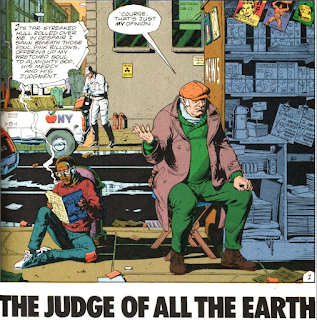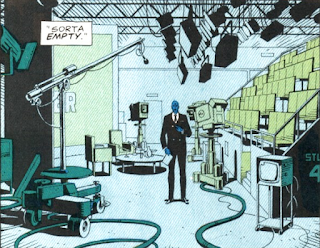"You walk into this room at your own risk, because it leads to the future, not a future that will be but one that might be. This is not a new world, it is simply an extension of what began in the old one."
"It has patterned itself after every dictator who has ever planted the ripping imprint of a boot on the pages of history…since the beginning of time. It has refinements, technological advancements, and a more sophisticated approach to the destruction of human freedom. But like every one of the super states that preceded it, it has one iron rule: logic is an enemy and truth is a menace.
"This is Mr. Romney Wordsworth, in his last forty-eight hours on Earth. He’s a citizen of the state but will soon have to be eliminated, because he’s built out of flesh and because he has a mind."
 |
| "Mr. Romney Wordsworth, who will draw his last breath… in the Twilight Zone." |
Once when I was a junior in high school, my English teacher asked me during class to go across the hall and into the supply room to grab some books for her. I had no idea this supply room ("Number Seven") existed. My imagination has undoubtedly exaggerated things over the years, but I remember a dimly lit, dusty little room, with floor-to-ceiling shelves and isolated stacks of books, mostly things that had fallen out of the curriculum.
One of them caught my eye:
 |
| You can read the whole thing for free at huxley.net if you so desire. |
No one told me there was a sequel to Brave New World, a book I'd read more than twice. (If it had to do with the State/ school / the PMRC telling you what you could think or how to rock, I was all about it back in those days.) I must have stood there flipping through it for awhile, and before too long I heard my teacher yelling at me to get back to class. I did, but I took a copy of Brave New World Revisited with me.
If you're unfamiliar with the book, it's a non-fiction examination of how the themes of Huxley's fictional novel (first published in 1932) were coming true with greater speed and horror than even he had predicted: "The nightmare of total organization, which I had situated in the seventh century After Ford, (London of 2540 AD ) has emerged from the safe, remote future and is now awaiting us, just around the next corner."
And that brings us to today's episode, something I saw right around the same time as I liberated this book from its dusty purgatory in Storage Room Seven:
 |
| Season 2, Episode 29. |
Mr. Wordsworth (Burgess Meredith) is called before the state to prove he is worthy of continued existence, despite his admission that he is a librarian, an obsolete and offensive profession. The Chancellor (Fritz Weaver) harangues him in front of his peers - the State's peers, not Mr. Wordsworth's:
"You're a dealer in books and two-cent fines and pamphlets and closed stacks and the musty insides of a language factory that spews out meaningless words on an assembly line- words, Mr. Wordsworth, that have no substance and no dimension. (...) Delusions that you inject into your veins with printer's ink; the narcotics that you call literature- the bible, poetry, essays- all of it an opiate to make you think you have a strength when you have no strength at all. You have nothing but spindly limbs and a dream, and the state has no use for your kind."
  |
| "You waste our time, Mr. Wordsworth, and you're not worth the waste." |
When Wordsworth further admits to belief in God, well, enough's enough. As mentioned here: "This is a future in which the State has 'proven' there is no God and has eliminated all books. If this State is the former United States of America, as one could easily infer from the American accents of the characters, then clearly the first amendment, too, has been rendered obsolete, if not the entire Constitution. In addition, the state routinely executes the obsolete live on television, for the 'educative effect (it has) on the population.' (...) It is this sort of televised set-up that Wordsworth requests for his own imminent death, but for the ulterior motive of showing his resolve."
After Mr. Wordsworth is condemned to death, the Chancellor - at Wordsworth's request - pays him a personal visit at his apartment. The victim is allowed to choose the method of his execution, and Mr. Wordsworth has chosen for his apartment to be destroyed by a bomb at the stroke of midnight. (The State is either exceedingly generous or a tad obtuse.)
Once the Chancellor arrives - and after some back-and-forth between them - Wordsworth reveals the door is locked and the building evacuated, as per official state procedure, and the Chancellor is trapped in there with him.
"How does a man react to the knowledge that he's going to be blown to bits within a half an hour?"
"That depends on the individual."
"Indeed it does."
  |
| ... |
 |
| ISWYDT. |
"You wanted the whole country to see the way that a librarian dies. Well, let the country see the way an official of the state dies, too."
As the time starts to tick down, Wordsworth settles into his armchair and reads from the Bible ("a crime punishable by death, so it's the only possession that I have that has any value at all to me."). The Chancellor begins to get nervous until, moments before detonation, he begs "in the name of God" to be set free. Having said the magic words, Wordsworth agrees and unlocks the door. As the Chancellor bolts to safety, Wordsworth turns towards the camera, just as the Chancellor instructed him to ("you're cheating the audience; they want to see how you die.") Then ka-boom.
This last-minute appeal to Christian charity is not, as we'll see, meant to convey a religious conversion of any kind on the part of the Chancellor, but neither is it in my mind a specifically pro-Christianity message from Serling. This was a show produced for American television of the late 50s and early 60s. Swap in whatever you like and it still works in 2016.
The Chancellor's fellow acolytes streamed the whole thing back at the Party Headquarters, and they have a little surprise for him when he returns to work the following morning:
  |
| The penalty for obsolescence in State officials is much more theatrical. |
 |
| Cults thrive on ritual. |
"The Chancellor - the late Chancellor - was only partly correct. He was obsolete. But so was the State, the entity he worshiped. Any state, any entity, any ideology that fails to recognize the worth, the dignity, the rights of man, that state is obsolete. A case to be filed under ‘M’ for mankind… in the Twilight Zone."
The End. Not the first or last Twilight Zone episode to explore the destruction of human rights at the dictate of the state.
It's by no means perfect. As mentioned here:
"The world (Serling) creates here pushes the tolerance of the audience. It is ominous simply for the sake of being ominous. A world populated by mindless, monotone citizens absolutely devoted to a callous, faceless government. The audience never really gets the sense of what the structure of this imagined future is supposed to accomplish; Serling simply fills his dystopia with any restriction of personal freedom that allows him to get his point across which is simply that totalitarianism is bad and a lack of free will is never fun."
While true I can shrug it off. Suspension of disbelief frees me to appreciate the intelligent and poetic remarks about the importance of art, philosophy, literature, freedom of religion, and free speech in a society. Sure, it's contrived; it makes little sense for the Chancellor to pay a personal visit to Wordsworth's home But is this sort of reckless arrogance on behalf of the State truly so outrageous? I wish that it were.
At one point, the Chancellor emphatically pronounces "Words-worth" to draw attention to the disgusting irony of his name. That was cool, but the Chancellor goes on to say "Mr. Wordsworth" somewhere around forty-four times in twenty-five minutes. I lost count. It might not be the orgy of name-excess that is " The Immunity Syndrome," but it sure gets repetitive fast. Serling was guilty of this in a number of his scripts. (See "Four O'Clock" and "Magic Dust" for more. Sometimes the guy could run a phrase into the ground.)
That said, much of the episode's success is due to the passion of its prose. It articulates many things within its admittedly broad strokes.
 |
| The excellent performances from Fritz Weaver and Burgess Meredith, both of whom return in other memorable TZ episodes, certainly don't hurt. |
~























































